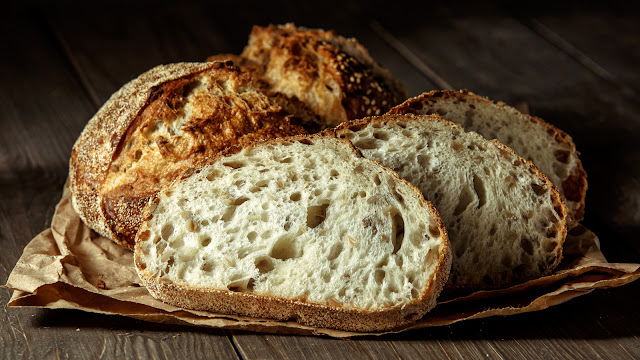 |
| Sourdough |
Sourdough bread has been around for centuries, tracing its origins back to
ancient Egypt, Greece and Rome. But in recent years, it has seen a renewed
interest as people look for artisan, nourishing breads made with simple
ingredients. Let's take a deeper look at this tradition of bread making and
what makes sourdough so special.
What is Sourdough?
Sourdough bread is made by a process called natural fermentation using a
sourdough starter rather than commercial yeast. A sourdough starter is made up
of flour, water and wild yeasts and lactobacilli bacteria that are naturally
present in flour and the air. When the starter is mixed with more flour and
water, the yeasts produce carbon dioxide bubbles while the lactobacilli produce
lactic and acetic acids, giving sourdough its signature sour taste.
This long, slow fermentation process of 12-24 hours allows the bread to develop
a rich, complex flavor quite unlike ordinary breads made with commercial yeast
which only takes 2-3 hours to rise. The natural acidity produced also makes
sourdough easier to digest than regular bread.
History of Sourdough Bread
Evidence suggests that early civilizations like the Egyptians who lacked
standardized leavening agents relied on naturally fermented sourdough starters
to make their bread rise. Sourdough
then spread throughout Europe and was an integral part of baking traditions.
During the gold rush era in America in the 1800s, pioneers carried their
starters across countries on wagon trains to have reliable access to bread.
International Varieties of Sourdough
While the basic sourdough process remains the same, different cultures have
developed unique varieties of this bread. Some examples include:
- France: Pain au Levain made with a rustic country-style sourdough starter.
- Germany: Sauerteigbrot known for its airy texture and chewiness.
- Russia: Khleb, a dark, dense sourdough bread often topped with seeds.
- San Francisco: Famous sourdough bread traceable to 1849 when gold miners
brought their starters.
Making Sourdough Bread at Home
With a little patience and care, you can make artisanal sourdough bread right
in your kitchen. The first step is cultivating your own starter by mixing flour
and water in a jar and allowing it to ferment on the counter for 7 days until
bubbles and a strong sour smell develop.
Then you can begin making dough recipes using your starter. The process
involves mixing flours, water and salt; folding the dough several times over
hours to develop gluten; shaping the dough and doing a long slow rise in the
fridge. Baking the bread completes the process. With practice, you'll be
proudly enjoying fresh, homemade sourdough.
Health Benefits of Sourdough Bread
Compared to regular yeasted bread, sourdough has several nutritional advantages
due to the fermentation process:
- Easier to digest: The lactobacilli in sourdough partially pre-digest gluten
making it less taxing on the digestive system.
- Probiotic qualities: The beneficial bacteria in sourdough can improve gut and
digestive health.
- Greater nutrient availability: Fermentation increases the bioavailability of
minerals like calcium, magnesium and zinc in the bread.
- Lower glycemic index: Sourdough doesn't cause as high a spike in blood sugar
levels as regular breads.
- Longer shelf life: The production of acids through fermentation prevents
staleness for a few days.
Moving Forward with Sourdough
As people become more sophisticated about artisan foods, interest in naturally
leavened sourdough bread seems destined to keep rising. Artisanal bakeries are
experimenting with creative flavors and global sourdough traditions are being
rediscovered. Home bakers are happy to cultivate their starters and develop
their baking skills. With its great taste and many health attributes, sourdough
promises to remain an integral part of bread culture for generations to come.
Get More Insights On This Topic: Sourdough
